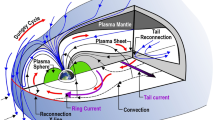Abstract
It is possible that the radially independent, spatial-spectral components of the energy and power of the potential part of the main geomagnetic field were determined and studied for the first time. Energy is obtained by integrating its known radial density from the core of the Earth to infinity, and power is a time derivative of energy. The total and spectral variations of energy and power from 1840 to 2020 are analyzed based on three generally accepted observational models of the geomagnetic field. The total energy (~6 × 1018 J) and power (~108 W) are determined by the sum of odd harmonics: dipole n = 1, octupole n = 3, etc. The dipole, the energy of which is close to the total energy symmetric with respect to the axis of rotation of the field, is predominant. The energy variations are ~10% and are similar for all models with the exception of the “burst” of the international geomagnetic reference field (IGRF) model in 1945–1950. Comparative spectral analysis showed that the “burst” is concentrated at n = 9 and 10, and the variations of the other harmonics are similar in all models. In this case, n = 3 dominates over n = 2. From n = 3 to 8, it decreases, and further n = 9 dominates over 8 and 10. The mean powers close to zero for n> 1 indicate an almost periodic behavior of the nondipole field, and significant power variations indicate a strong nonlinearity of the geodynamo. The results of the work are consistent with modern geodynamo-like models. The fact that such a significant IGRF “burst” that can have a non-linear geodynamic nature is a challenge. Alternatively, this may be some consequence of the imperfections of the IGRF model. Two other too-"quiet" models were subjected to excessive smoothing.






Similar content being viewed by others
REFERENCES
Bondar, T.N., Golovkov, V.P., and Yakovleva, S.V., Spatiotemporal model of the secular variations of the geomagnetic field in the time interval from 1500 through 2000, Geomagn. Aeron. (Engl. Transl.), 2002, vol. 42, no. 6, pp. 793–800.
Gauss, K.F., Izbrannye trudy po zemnomu magnetizmu (Selected Works on Terrestrial Magnetism), Moscow: Izd. Akad. Nauk SSSR, 1952.
Gillet, N., Barrois, O., and Finlay, C.C., Stochastic forecasting of the geomagnetic field from the COV-OBS.x1 geomagnetic field model, and candidate models for IGRF-12, Earth, Planet and Space, 2015, vol. 67, id 71. https://doi.org/10.1186/s40623-015-0225-z
Jackson, A., Jonkers, A.R.T., and Walker, M.R., Four centuries of geomagnetic secular variation from historical records, Phil. Trans. R. Soc. London, 2000, vol. A358, pp. 957–990.
Lowes, F.J., Mean-square values on sphere of spherical harmonic vector fields, J. Geophys. Res., 1966, vol. 71, no. 8, p. 2179.
Lowes, F.J., Spatial power spectrum of the main geomagnetic field, and extrapolation to the core, Geophys. J. R. Astron. Soc., 1974, vol. 36, pp. 717–730.
Mauersberger, P., Das Mittel der Energiedichte des geomagnetischen Hauptfeldes an der Erdoberflache und seine säkulare Änderung, Gerlands Beitrage Geophys., 1956, vol. 65, pp. 207–2015.
Schaeffer, N., Jault, D., Nataf, H.-C., and Fournier, A., Turbulent geodynamo simulations: A leap towards Earth’s core, Geophys. J. Int., 2017, vol. 211, pp. 1–29.
Starchenko, S.V., Analytic base of geodynamo-like scaling laws in the planets, geomagnetic periodicities and inversions, Geomagn. Aeron. (Engl. Transl.), 2014, vol. 54, no. 6, pp. 694–701.
Yanovskii, B.M., Zemnoi magnetizm (Terrestrial Magnetism), Leningrad: LGU, 1978.
Zvereva, T.I., Dynamics of the main magnetic field of the Earth from 1900 until present days, in Yubileinyi sbornik IZMIRAN-75 “Elektromagnitnye protsessy ot nedr Solntsa do nedr Zemli” (Jubilee Volume IZMIRAN-75 “Electromagnetic Processes from the Sun’s Interiors to the Earth’s Interiors”), Moscow: IZMIRAN, 2015, pp. 36–45.
ACKNOWLEDGMENTS
The authors are deeply grateful to the anonymous reviewer. His comments helped to improve significantly the presentation of this work, which was done mainly at the expense of the IZMIRAN budget. For geodynamo applications, partial support was provided by the Russian Foundation for Basic Research (project no. 16-05-00507-a).
Author information
Authors and Affiliations
Corresponding author
Additional information
Translated by E. Seifina
Rights and permissions
About this article
Cite this article
Starchenko, S.V., Yakovleva, S.V. Energy and Power Spectra of the Potential Geomagnetic Field since 1840. Geomagn. Aeron. 59, 242–248 (2019). https://doi.org/10.1134/S0016793219010122
Received:
Revised:
Accepted:
Published:
Issue Date:
DOI: https://doi.org/10.1134/S0016793219010122




